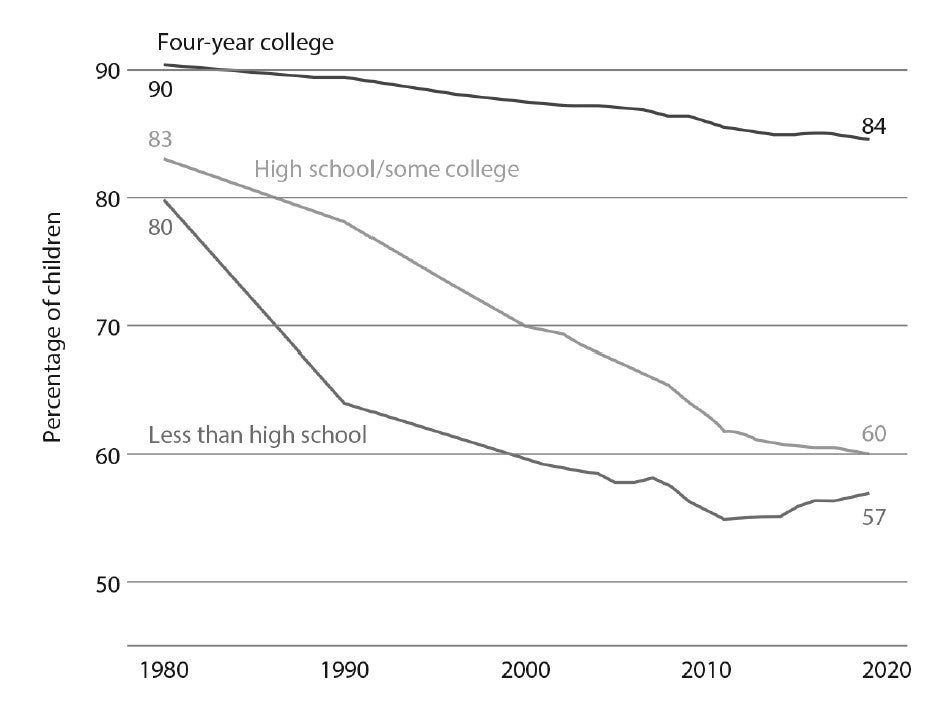
IN BRIEF: The Wide Class Divide in Family Structure

BRIEFLY:
Children in the US are far less likely to be raised in two-parent families today than they were in prior decades, a shift Aspen Economic Strategy Group (AESG) director Melissa Kearney explores in her new book, The Two-Parent Privilege.
US children are now more likely than those in any other country to live in a one-parent home. This trend has been driven by a reduction in marriage among US adults, including parents. From 1980 to 2019, there was a dramatic decline in the share of children living with married parents—the share fell from 77 percent to 63 percent. The largest declines were among children of mothers without a college degree, leading to what Kearney refers to as a “college gap” in children’s household structures. This trend both reflects and exacerbates a wide class divide in economic circumstances and security: without the resources and support of a two-parent family, children are less likely to graduate high school, get a college degree, or have high earnings in adulthood. Consequently, the class gap in family structure heightens economic inequality and perpetuates it across generations.
WHAT TO KNOW:
- Far fewer children are raised in two-parent households today, and that decline has occurred mostly outside the college-educated class. From 1980 to 2019, the share of children living with married parents fell from 77 percent to 63 percent. Importantly, this trend was not driven by high-income mothers raising children alone: the share of children living with married parents fell only 6 percentage points among those whose mother had a four-year college degree, from 90 percent to 84 percent. In contrast, among children whose mothers had only a high school degree or some college, the share fell from 83 percent to 60 percent and from 80 percent to 57 percent among children whose mother had less than a high school degree.
Figure 1: Percentage of children living with married parents, by maternal education level

Source: The Two-Parent Privilege (author’s calculations using 1980 and 1990 US decennial census and 2000 2019 US census American Community Survey, with observations weighted using child’s survey weight)
- The socioeconomic class gap in family structure contributes to widening inequality and reduced social mobility in the US. Families are a source of both financial and nonfinancial resources that benefit children. Parents provide not only love and strong connections but time and money as well. When two parents are present in a household, they tend to have more income, more time, and more energy to devote to a child’s development. Crucially, the class divide in two-parent households is partly driven by inequality of economic opportunities, but it also widens class gaps. Parents with less education have less economic security, and they are less likely to be married and raise their children together. Their children grow up with fewer resources and opportunities: low-income families spend about half as much on child education and enrichment activities as do those in the middle of the income distribution ($1,421 per child in 2007 versus $750 for low-income parents). Further, children of unmarried parents spend 7.6 fewer hours per week with their children. These kids, in turn, are more likely to get in trouble in school, to be involved in crimes as adolescents, to have lower incomes as adults, and to have children out of marriage—starting the cycle all over again.
- Young boys are particularly responsive to parental input and to the presence of fathers or father figures. Raising a family alone often means having fewer financial resources and less time and emotional bandwidth to offer one’s children. Research by the economists Marianne Bertrand and Jessica Pan found that boys are more sensitive than girls to these differences in resources, contributing to the relatively worse outcomes of boys as compared to girls. For instance, the elevated rate at which boys get in trouble at school is even higher among boys from single-mother households. Other research has found that beyond the beneficial presence of fathers in one own’s household, boys—Black boys in particular—benefit from having more fathers in the neighborhood. Research from Harvard University’s Opportunity Insights team found that the presence of Black fathers in a neighborhood is one of the strongest predictors of whether Black boys will move up the income distribution later in life.
- This rise in children living in single-parent households is not driven by divorce and comes despite a decline in births among young women. Today, a smaller share of unmarried mothers has been divorced and a greater share has never been married than in previous decades. In 2019, 52 percent of unpartnered mothers (meaning mothers living in a household without either a spouse or an unmarried partner) had never been married, as compared to 22 percent in 1980. Further, as Kearney and Phil Levine report in their 2022 AESG policy chapter, birth rates in America have fallen among women under 30 years old, with especially steep declines among teenagers. In sum, the rise in single-mother households reflects a rise in nonmarital births, not an increase of births to teen or young women—and it is not a function of rising divorce.
- These trends reflect, in part, reduced economic opportunities among non-college-educated men and changing social norms around marriage and childbearing. Marriage is both a source of companionship and an economic partnership. As men without a college degree have lost ground economically (both in absolute terms and relative to women) their marriage rates have fallen. From 1980 to 2020, among men without a four-year college degree, employment rates fell, and median inflation-adjusted earnings hardly changed. Among working men ages 30 to 50, in both 1980 and 2020, median earnings were just below $49,000 for those with just a high school degree and just below $35,000 for those with less than a high school degree. Over the same time frame, marriage rates among these two groups of men fell sharply, from nearly 80 percent to less than 55 percent. This trend stands in contrast to the situation among college-educated men, whose earnings over this time soared and whose marriage rates fell much less, from about 80 percent to 70 percent. Indeed, the decline in domestic manufacturing jobs in the US has been associated with reduced economic opportunity for men without a college degree—and economists have found that reduction caused a decline in marriage rates and a rise in the share of children living in single-mother homes.
- As relaxed norms around nonmarital childbearing have emerged, it is not clear that reversing this economic decline is a silver bullet to turning marriage rates around. In a 2018 study, Kearney and Riley Wilson found that areas where men without a college degree experienced increased economic opportunity (from local fracking booms) saw a rise in births—but this rise was in equal proportion among married and unmarried parents, and it brought no associated rise in marriage rates. Their study contrasts this family-formation response with the response to a similar economic shock in the 1970s and 1980s. Local coal booms at that time led to an increase in male earnings in coal-producing communities; they led, too, to an associated increase in marriage and in births to married couples, as well as to a decrease in the share of nonmarital births. This research suggests an important interaction between economic shocks and prevailing social norms; the high share of children being born and raised outside marriage today likely reflects both economic and social conditions.
- To address this trend, Kearney concludes that the US needs a dedicated effort to strengthen families, especially among groups for whom one-parent homes have become commonplace. The evidence marshalled in Kearney’s book suggests that both the evolution of social norms away from marriage and two-parent families and the economic struggles of non-college-educated men have contributed to the rise in the share of children living with only one parent (typically their mother) and to a wide class gap in family structure. She concludes that addressing the resulting challenge will require improving the economic opportunities of non-college-educated men, which will make marriage a more attractive option, as well as promoting a norm of two-parent homes for children. She also suggests that US policies and programs should promote strong and healthy family units in cases where parents cannot, should not, or do not want to be married, and they should continue to promote and scale evidence-based programs that help children from under-resourced, often single-parent, homes.
THE BOTTOM LINE:
Family structure is often avoided as a topic of policy conversations, as it is a personal and sensitive topic, and less obviously responsive to policy intervention than other issues related to inequality and social mobility, like educational attainment or wages. But as both symptoms and causes of economic challenges in the United States—including widening income inequality and reduced economic mobility—the high share of US children being raised in a one-parent home and the wide class gap in family structure cannot be ignored. Kearney argues in her new book that strengthening families must be a US policy priority: doing so will be key to achieving our nation’s aim to advance child well-being, break intergenerational cycles of economic disadvantage, and promote equal opportunity and social mobility.